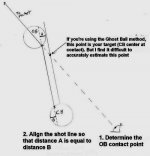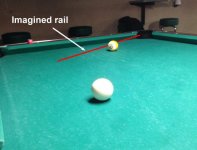I can't write the whole thing down, it's too damned long! I'll try anyhow.
Started with:
1. Spinning balls in, Strickland method. I aimed most balls almost full on and squirted/threw the balls in.
2. Then ghostball. Still my system of choice. Flexible, applicable to all situations.
3. Aiming by the numbers: First commercial system bought. As such systems go I have to give it very high marks indeed, it is IMHO one of the best systems available for beginners and intermediates alike if you don't like ghostball/quarter system. Nice package with balls, booklet, DVD and book with which to chart your progress on various drills. The system works well for most shots, although...maybe not if you like to soft roll a lot of cutshots, you will have to compensate on some shots. I still use the balls (very nice quality Aramith), the drill book (great idea and implementation), and the system itself on a certain category of shots.
4. I then bought the SEE system. It is in contention as best system. Very nice package with video and pdf file. Smart way to integrate alignment into the aiming process. I still use the footwork from this system, and some of the info as well. It works very well, can be a bit complicated and is very demanding of your preshot routine. You'd better control your stepping in, or you're going to have a hard time...
5. CTE....I know I'll get a lot of flak for this, but I'm not going to lie about it. After being very sceptical for a long period of time, all the hype finally convinced me to buy Stans first DVD. . At the time I didn't post anything about it, as I was primarily a lurker. I spent a full month with it at the snooker table and gave it my very best shot. I tried everything in my power to make it work, and I do mean EVERYTHING. I had time off from work and spent the full day working on it...Couldn't make strict CTE work consistently, went to Pro 1 and got it to work, sort of...I only tried DVD1 and watched some youtube videos, but can't give the material I watched very high marks. All I got was a DVD for a very high price, which in my opinion did not fully explain the aiming process, at least in a way which could be easily understood by me. To be frank, I felt ripped off, at least compared to my very nice experience with SEE and Aiming by the numbers. To this day I wonder if the whole thing is just a scam or if I'm missing 1 extremely critical piece of information to make it all work perfectly...
6. TOI. Experimented with it. Pocketed quite a few balls and was sure it was the best thing ever..Then I started looking deeper into it, trying to beat the 10ball ghost with it..I then discovered some serious drawbacks, IMO, with the system, at least when applied to all shots. At the time I thought my fundamentals were too bad, since I kept getting some residual inside on a lot of shots and I had trouble making the absolute longest almost straight in shots..Then I started wondering why this hardly ever happens when I use center ball...If I can hit perfect stop shots without residual spin, my fundamentals can't be too bad..I bought the pay per view rather cheaply (on a sale). The price was fairly low, but I still don't think it was a very good value. I could go into details, but I'm trying to keep this short.
7. I've tried every new system that has been made available for free, including a very surprisingly effective one posted by 8pack here on the forum. That system works extremely well. Worth checking out if you want to try pivot aiming. And its free to boot!
8. I've lost most of my interest in buying and trying aiming systems. I use elements from SEE and aiming by the numbers, but most of my aiming is ghostball based or ghostball/contact point hybrid. I can't fully explain what I'm doing but it seems to work ok. If I ever get the chance to view the second DVD of CTE for free, I might do it out of sheer curiosity to see if some things might be made clear to me, that it may click...I don't have high hopes, though. So you see I have put rather a lot of money into pool aiming systems...I hope others can learn from my experiences.

